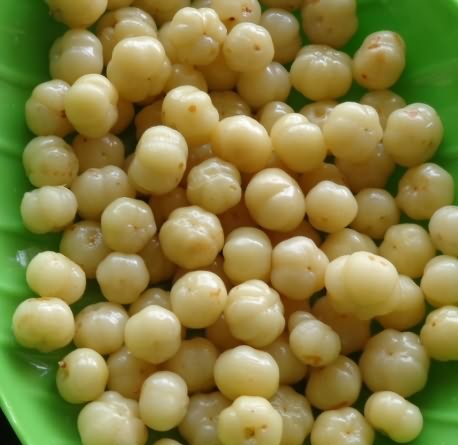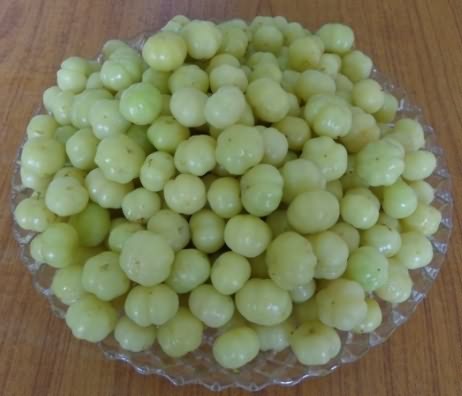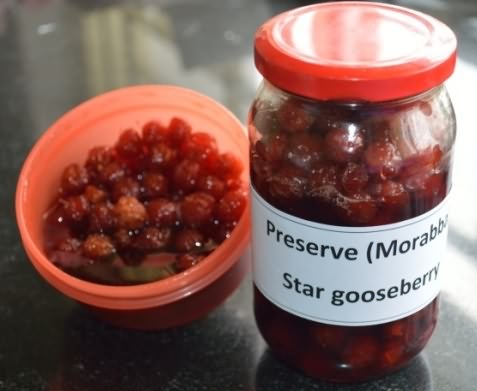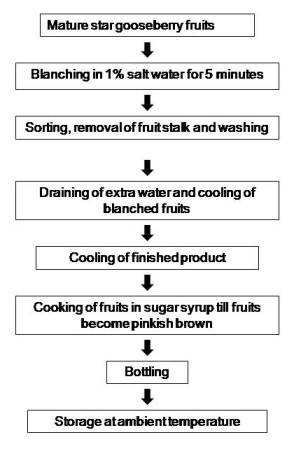स्टार करौदा परिरक्षण (मुरब्बा): बेरी का एक पोषक मूल्य संंर्वधक उत्पाद
Star gooseberry, an underutilized fruit crop of Indian origin, has not yet been exploited properly in spite of its nutritional and medicinal values. In comparison to aonla / amla, it has limited market potential. However, its potential may be realized by developing and promoting its value added products.

Bearing plant of star gooseberry
Preserve may be helpful in popularizing vitamin C rich star gooseberry among masses.
Star gooseberry (Phyllanthus acidus Skeels), a close relative of aonla (Emblica officinalis Geartn) is an underutilized fruit crop of India. It is a component of homestead gardens of tropical/ subtropical humid regions of the country.
In Odisha it is known as ‘Narkoli’ and cultivated primarily in backyard. Narkoli bears fruits thrice in a year i.e. during March-April, June-July and Oct-November. Fruits are pale yellow, waxy, crispy, ribbed and smaller than aonla.
It is a rich source of vitamin C (85-95 mg/100g of edible portion) and minerals. Traditionally, fruits are used as blood purifier, appetite stimulant and as a remedy for bronchitis, biliousness and digestive disorders. However, it has limited market as fresh fruit due to high acidity and astringency.
Fruits are highly perishable in nature and can hardly be stored for 2-3 days at room temperature. Hence, it is necessary to process this fruit and develop novel products to enhance its market potential. An attempt was made to develop methodology for star gooseberry preserve/ murabba preparation.
Methodology of gooseberry preserve:
Ingredients and the process used for preparation of star gooseberry preserve are being described below-
Ingredients:
Star gooseberry fruits (1.0kg), Salt solution (1.0%) and Sugar (750g)
Process of making star gooseberry preserve:
- Mature fruits (pale yellow) were harvested, all the blemished, damaged and undersized fruits were discarded and only healthy fruits were selected for preserve making.
- Fruit stalks were removed and selected fruits were thoroughly washed in water to remove dust and unwanted materials.
- Fruits were blanched in boiling salt water (1.0%) for 5 minutes to make them soft. Water was drained out and blanched fruits were allowed to cool by keeping them under running water.
- Sugar syrup of one string consistency was prepared by heating 750g of sugar in 500ml of water with intermittent stirring.
- Blanched star gooseberry fruits were cooked on low flame in the freshly prepared sugar syrup. Cooking was continued till the fruits changed their colour into pinkish brown. The final concentration of the sugar in the product was 68-70%. Then the product was allowed to cool and packed in bottles. The preserve developed by this method was found to last for 4-6 months when stored at room temperature



The process of preserve making is also being described by the flow chart

The product was organoleptically evaluated on the basis of Hedonic scale (1-7) and was found highly acceptable (6.5/7). Sour and astringent fruits of star gooseberry are less preferred as table fruits. However, its nutritive and therapeutic values offer great potential for processing. Hence, preserve would be very helpful in enhancing the market potential of this underutilized fruit crop.
Authors:
Deepa Samant* and Kundan Kishore
Central Horticultural Experiment Station (ICAR-IIHR),
Aiginia, Bhubaneswar-751 019, Odisha
